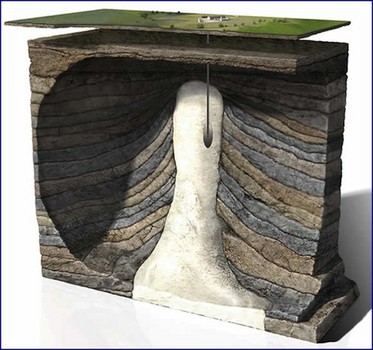On May 7, 2008, a sinkhole suddenly developed in the town of Daisetta, Texas, on the northwest quadrant of an underlying salt dome. The hole quickly expanded from a diameter of about 20 feet to the size of several football fields, swallowing buildings, vehicles, telephone poles, oil field equipment and tanks. After several days, the sinkhole stopped growing and stabilized, eventually filling with water and forming the nice “lake” visible at the posted coordinates.
GEOLOGY:
A salt dome is a largely subsurface geologic structure that consists of a vertical cylinder of salt 1 km (0.6 mile) or more in diameter, embedded in horizontal or inclined strata. The embedded material in all instances appears to have pierced surrounding rocks. Upward flow is believed to be caused by gravity in situations where relatively heavy rocks overlie the lighter salt mass, which then rises like cream to the surface. Along the Gulf Coast, salt domes consist virtually of pure halite (sodium chloride) with minor amounts of anhydrite (calcium sulfate) and traces of other minerals. In the broadest sense, the term “salt dome” includes both the core of salt and the strata that surround and are “domed” by the core.

The rock salt that is found in salt domes is mostly impermeable. As the salt moves up towards the surface, it can penetrate and/or bend strata of existing rock with it. As these strata are penetrated, they are generally bent slightly upwards at the point of contact with the dome, and can form pockets where petroleum and natural gas can collect between impermeable strata of rock and the salt. The strata immediately above the dome that are not penetrated are pushed upward, creating a dome-like reservoir above the salt where petroleum can also gather. These oil pools can eventually be extracted, and indeed form a major source of the petroleum produced along the coast of the Gulf of Mexico. The town of Daisetta sits atop a salt dome and has a long history of oil and gas production.

Sinkholes over salt domes are a natural phenomena and a geohazard for the Gulf Coast. Two similarly sized sinkholes formed in June 1980 (Wink 1) and May 2002 (Wink 2) in an oilfield over Permian salt beds near the communities of Wink and Kermit in western Texas. Typically, these sinkholes are not the result of the collapse of the salt dome itself but are caused by a collapse of a solution cavity in the salt and/or caprock. At the Daisetta sinkhole, an oil field services company had been operating a wastewater disposal well on the site within 200 feet of the sinkhole and some geologists have suggested that this operation may have triggered the sinkhole formation. The waste saltwater is a byproduct of oil production and has to be stored underground so it won't contaminate water supplies and the environment. The Texas Railroad Commission, which regulates oil and gas production in the state and issued the permit for the disposal well, has been studying the matter but has yet to find a link between the well and the formation of the sinkhole.
THE CACHE

The listed coordinates will take you to a small pull-off along FM770 in Daisetta. The sinkhole is located due west of this spot and can somewhat be seen from the road. It is not necessary to cross onto any private property. Take a picture at this location with you and/or your GPSr plainly visible and the sinkhole in the background. Post this picture in your log.
Email or message me the answers to the following questions:
1.) What is on the black and white road sign just south of the coordinates?
2.) Estimated the width of the sinkhole as you look at it (east to west).
3.)This sinkhole is a bit of an anomaly as it has occurred over a salt dome. Over what type of geologic formation do the majority of sinkholes occur? You can find this answer easily online. Most of the sinkhole earthcaches on Earthcache.org are listed under this classification.
Please don't post your answers or any spoiler pictures in you log!
This cache created by a Platinum Earthcache Master
See Earthcache.org for more info on how to become an Earthcache Master.
Congratulations to WTT-B2 for being FTF!